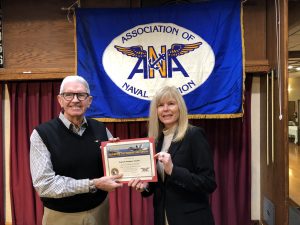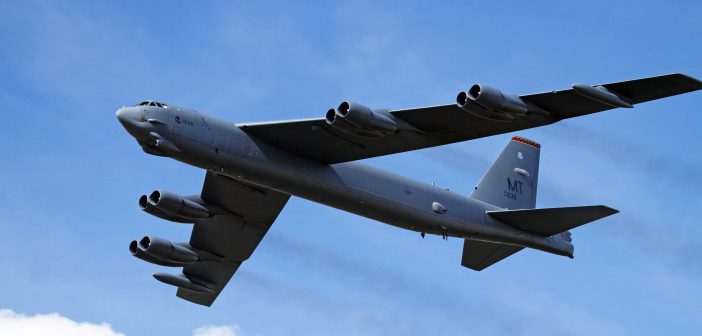 The Grampaw Pettibone Squadron was honored to have as a returning guest speaker, Mr. Stephen Tucker. During his previous visit Stephen shared his knowledge and experience serving as a US Marine Corps helicopter pilot at the battle of Khe Sanh, South Vietnam, during the Tet Offensive of 1968. His talk provided an overview of the history and service of the Boeing B-52 Stratofortress, an American long-range, subsonic jet powered strategic bomber.
The Grampaw Pettibone Squadron was honored to have as a returning guest speaker, Mr. Stephen Tucker. During his previous visit Stephen shared his knowledge and experience serving as a US Marine Corps helicopter pilot at the battle of Khe Sanh, South Vietnam, during the Tet Offensive of 1968. His talk provided an overview of the history and service of the Boeing B-52 Stratofortress, an American long-range, subsonic jet powered strategic bomber.
The Boeing B-52 development began in 1946 as a Cold War deterrent with capability to carry nuclear weapons. While the aircraft has been used in several military engagements, it has dropped only conventional weapons.
The first operational version, the B-52B in 1956 cost $14.4mm ($99.9mm in 2016 dollars) to build. The last model B-52H in 1962 cost $9.3mm ($57.8mm in 2016 dollars). As Stephen remarked, the more you build, the cheaper it gets.
The initial design began as a straight wing, six turboprop engines, straight tail, tandem cockpit. It evolved over the course of design from 1946-1952 when the maiden flight occurred. By this time, the aircraft was a swept wing, eight turbojets, swept wing tail, side by side cockpit.
Prior to the development of a jet powered strategic bomber, the US began design on an intercontinental strategic bomber, the Convair B-36. Initial design began in 1941 before the US entered WWII. The aircraft design contained six pusher prop engines that were subsequently augmented by a pair of jet engines on each wing. Due to its size, it was only able to land at three US Air Force Bases. The introduction of the jet age made this aircraft obsolete even before its first flight in 1946. The operational life of 384 aircraft between 1948-1959 did not see a bomb dropped or gun fired against an enemy. Our speaker noted that the aircraft was also known as the “Billion $ Blunder”.
A sample of the dimensions and operational capability of B-52 v B-17; Crew 5 v 10; Length 160.89 ft v 74.74 ft; Wing Span 185.10 v 103.74 ft; Power 8-jet, 17k lbs thrust each v 4-radial, 1200 hp each; Range 8800 v 2000 miles; Ceiling 70,000 v 35,600; Payload 70,000 lbs v 4500 to 8000 lbs
In 1951, three B-52A models were built, however, none became operational. This aircraft first flew in 1952 and the first operational model “B” flew in 1954. A total of 744 B-52’s, representing all versions were produced. Only the “H” model, delivered in 1962 with 76 aircraft remaining in service are still operational.
Records indicate the aircraft life span may well extend beyond 2050. It is considered by experts as the most successful military aircraft ever produced.
Sharing his research, our speaker noted that while the principal mission of the B-52 was nuclear deterrence, the mission was adjusted with the introduction of high speed jet interceptors and surface-to-air-missiles.
 The B-52 introduction to Vietnam in 1965 saw a total of 28 aircraft release their load on enemy troop concentrations in heavily forested area near Saigon. During this first year over 1500 missions were conducted with an average bomb tonnage of 17 per mission. While the media criticized the use of the aircraft, and In spite of the initial design role, the B-52 most effective use in Vietnam was for tactical support of ground troops.
The B-52 introduction to Vietnam in 1965 saw a total of 28 aircraft release their load on enemy troop concentrations in heavily forested area near Saigon. During this first year over 1500 missions were conducted with an average bomb tonnage of 17 per mission. While the media criticized the use of the aircraft, and In spite of the initial design role, the B-52 most effective use in Vietnam was for tactical support of ground troops.
The aircraft acquired nicknames as a result of its service roles in Vietnam. The NVA called it ‘Whispering Death’ , due to the arrival of the bombs, without any sound of approaching aircraft. Rolling Thunder, the sound of three aircraft dropping 318 or more bombs in a carpet bombing mode. Finally, BUFF – ‘Big Ugly Fat Fellows’, a term of endearment from the troops.
Steve shared his research regarding the description of the aircraft. A career B-52 pilot said, “this airplane has the power of 8 locomotives, a thousand miles of wire, made from enough aluminum to make 10,000 trash cans. Therefore, it flies like 8 locomotives dragging 10,000 trash cans on a thousand miles of wire!”
Comments from experienced crews note the performance of the aircraft is due to; good design and upgrades. Constant modification delivers a current version that barely resembles its original model with performance that exceeds all expectation.
During Vietnam a six man crew manned the aircraft. Ejection seats were configured for the navigator and radar navigator to eject out the bottom of the aircraft in separate egress hatches, while the pilot, co-pilot and rear seated weapons officers upward through separate hatches.
Crew configuration included a tail gunner from the ‘A’ through ‘F’ model with capability to jettison the turret in an emergency. The ‘G’ model had a remotely operated 20mm cannon in the tail and by 1991 the tail gun was removed from aircraft configuration.
With excessive turbulence in flight, the tail gunner was exposed to severe physical challenges and potential injury which could reduce crew effectiveness. The design of the tall tail and extreme turbulent conditions at altitude led to a redesign for a shorter tail beginning with the ‘G’ model, reducing the severity of the tail wag.
The B-52 contributed to the dropping of 7 million tons of bombs during Vietnam compared to WWII dropping of 2 million tons. The contribution made by the B-52 during Vietnam was a factor in saving the aircraft. During the Khe Sanh siege, B-52s dropped over 59,500 tons of bombs at the rate of 3 aircraft every 3 hours releasing 360,000 pounds at a time.
Total B-52 losses caused by combat loss, operational loss and terminal mission damage were 61 aircraft. A total of 126,615 sorties were flown between June 1965 and August 1975. MiG losses to B-52 guns occurred in December 1972 when two separate missions led to the confirmed loss of two MiGs.
The B-52 was the launch platform for the X-15 program. In spite of the aircraft age, it is more economical to maintain and with numerous upgrades will outlast other strategic mission aircraft such as the B-1B and B-2. The design, structural integrity and long history was amply demonstrated when during a mission in 1964 it encountered severe turbulence resulting in the loss of 85% of its tail. It was able to return to its home base and land safely. The aircraft was repaired and the airframe strengthened and returned to service before finally being retired in 2008.
As a result of START Treaty compliance in 1991, 365 B-52 ‘G’ models were destroyed. During Desert Storm air operations, B-52 ‘G’ models were responsible for 1/3 of all air tonnage as well as cruise missile and other air/ground launches.
The B-52 is one of the very few American weapons that has never been provided to any ally.




